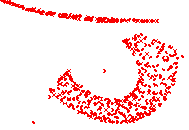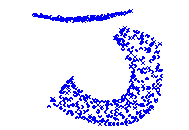MAGION spacecraft attitude control: twisting at the edge of abyss.
From NATAN EISMONT
August 24,1995
MAGION spacecraft was planned to be separated from the main spacecraft
on the second orbit after the launch at the distance from the control
ground station not further then 100000 km. The separation impulse was expected
to be equal 0.3 m/s directed in antisun point. This direction coincides with the spin axis of the main spacecraft.
The minimum velocity of the spacecraft divergence was strougly desirable at
the initial phase of the mission. This demands leads to the maximum height
permissible for the separation.
Maximum limit of height was determined by the radiolink reliability and was admitted equal mentioned 100000 km.
Second orbit for separation was chosen in order to guarantee proper stabilization of the main spacecraft. Difficult problem was to keep the temperature of the MAGION chemical battery before its separation in allowable limits. So special heaters have been installed onboard MAGION receiving electrical power from the main spacecraft.
Two hours after the separation the pair of spacecraft from the launch vehicle
fourth stage, the operations to stabilize main spacecraft have began and have been finished far ahead plans.
After the checking the main spacecraft attitude and main housekeeping systems the control group came to the conclusion of possibility to separate MAGION on the first orbit. It allowed to bypass very difficult problem to keep the temperature of MAGION chemical battery in prescribed limits durind 91.5 hours of the orbital period.
The decision has been taken and MAGION has been separated from the main spacecraft at 9 hours 25 minutes UTC August the 3rd.
After separation the automatic system of solar panels and booms are to be activated as 136 MHz transmitter. But no signal from the spacecraft has been detected as it was escaping from 100000 km zone.
Next 4 days were not the best days for the team from Czech Institute of Atmospheric Physics which has developed the MAGION spacecraft as for the whole INTERBALL team.
And then when MAGION returned to the Earth the command has been sent to switch on 136 MHz transmitter at 20 hours 20 minutes UTC August the 6th and detection of the signal has at last happen. It was met as a great victory.
But the voltage on the battery was below tolerable limits, so it was impossible to switch on the full scale telemetry system for sure diagnostics only.
The minimum data set was available. Their analysis (solar panels currents and temperatures on the surfaces of the spacecraft body) led to conclusion that not all solar panels and booms are deployed. And in addition the solar sensors did not see the Sun.
It meant that the spin axis was directed to the point in the hemisphere opposite to the Sun.
Attempts to deploy the folded solar panels and booms failed because of too low voltage. In this conditions spacecraft has gone to the apogee region with systems switch off in order to charge chemical batteries.
After next return of the spacecraft into perigee region at 6 hours 22 minutes UTC August the 10thslow telemetry has been switched on and commands on deployment of the panels and booms have been sent onboard. As a result all panels and all booms exept one small panel and one boom have been deployed.
But Sun still was not in the field of view of solar sensors.
In order to fulfill attitude maneuver some assumptions about attitude were unavoidable. So it was assumed the initial angular momentum vector went along Sun direction at the separation moment. Thus generating big enough angle between angular momentum vector and Sun by shifting this vector into the hemisphere of solar sensors one could hope to observe Sun in solar sensors field of view.
The simplest way to fulfill it was to accelerate spacecraft around -Z axis.
Followind this approach so called +R thrusters have been switched on at 18 hours 54 minutes UTC August the for 10 seconds giving additional component to the angular momentum along -Z axis.
As a result during next return of the spacecraft after switching on the telemetry at 5 hours 08 minutes UTC August 14th it was registered the full charge of the chemical battery and Sun mainly in the field of view of solar sensors.
Analysis of their measurements have shown the rotation proceeds in the region of the axis of minimum inertia moment, which lies approximately in (-Z), (-X)
plane under 50 degrees towards (-Z) axis.
The angle between this axis and angular momentum was from 30 to 50 degrees and angle between angular momentum and Sun about 30 degrees.
Spin period was estimated to be 80 seconds and period of angular momentum about 25 minutes.
Trying to improve attitude maneuver has been mistakenly exequted. As a result
spacecraft returned 18 August with almost discharged batteries (voltage about 10v). It was observed beginning from 0 hours 30 minutes UTC. Using so called Ko
thruster which generates moment orthogonal to Z axis attitude was slightly improved with consequent improvement of power supply.
Decisive attitude maneuver have been fulfilled during control session at August the 22d.
After several attitude maneuvers with use of Ko and +R thrusters the rotation around maximum inertia moment axis has been achieved. This axis has the projections on -ZX and -ZY planes with their angles +40 degrees and -13 degrees with -Z axis correspondingly.
The nutation angle was achieved approximately 5 degrees ang angle between Sun and angular moment ~ 18 degrees. In order to use early developed computer program for attitude control the solar sensors measurements were transformed to the new axis with new axis -Zn going along mentioned inertia axis and Xn, Yn directed in such a way that Ko control moment projection on XnYn plane lies under 45 degrees between them as it was for nominal inertia axis position.

Fig.1
The measurements of the solar sensors are in applied Fig. 1 with alpha angle as the angle between -Zn axis and projection of the Sun onto (-Zn),Y plane, and beta angle as the angle between -Zn axis and projection of the Sun onto (-Zn),X plane.
Fig. 1 contains the same parameter but for axis rotated to principal inertia axis. The points at the upper part of the Fig. 1,2 are suppose to be the result of ligth reflection from some construction elements of the spacecraft.

Fig.2
Further attitude maneuvers are aimed to move the inertia axis -Zn toward Sun with minimum nutation, i.e. to reach the coincideness of angular momentum vector, Sun vector and inertia axis -Zn.
Then it is planned to slow the spin to the period about 5 minutes which may allow spacecraft -Zn axis follow Sun direction with some osculation of angle between them.
The team consising of
N.Eismont, E.Ryazanova (Space Research Institute (IKI), Moscow)
J.Hum, V.Truhlik, P.Chennohuby (Institute of Atmospheric Physics (UFA), Czech Republic)
will continue these operations.
The head of overall MAGION control operations is
Pavel Triska (UFA).
neismont@esoc1.iki.rssi.ru

 Back to the Latest News
Back to the Latest News


